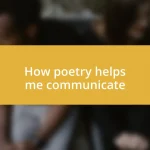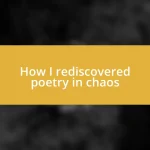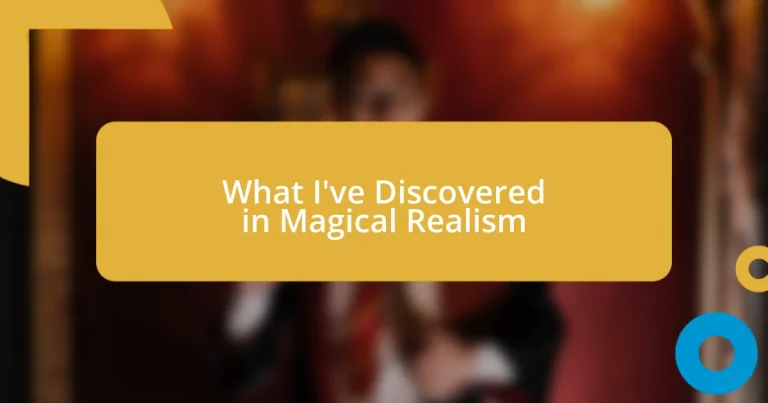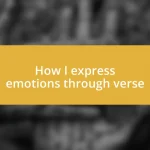Key takeaways:
- Magical realism intertwines the extraordinary with the everyday, allowing readers to explore complex emotional truths and cultural histories.
- Key characteristics include the seamless blend of ordinary and extraordinary elements, richly detailed settings, and characters that reflect societal issues.
- Influential authors like Gabriel García Márquez and Isabel Allende shape the genre by incorporating personal and cultural narratives that resonate with readers on multiple levels.
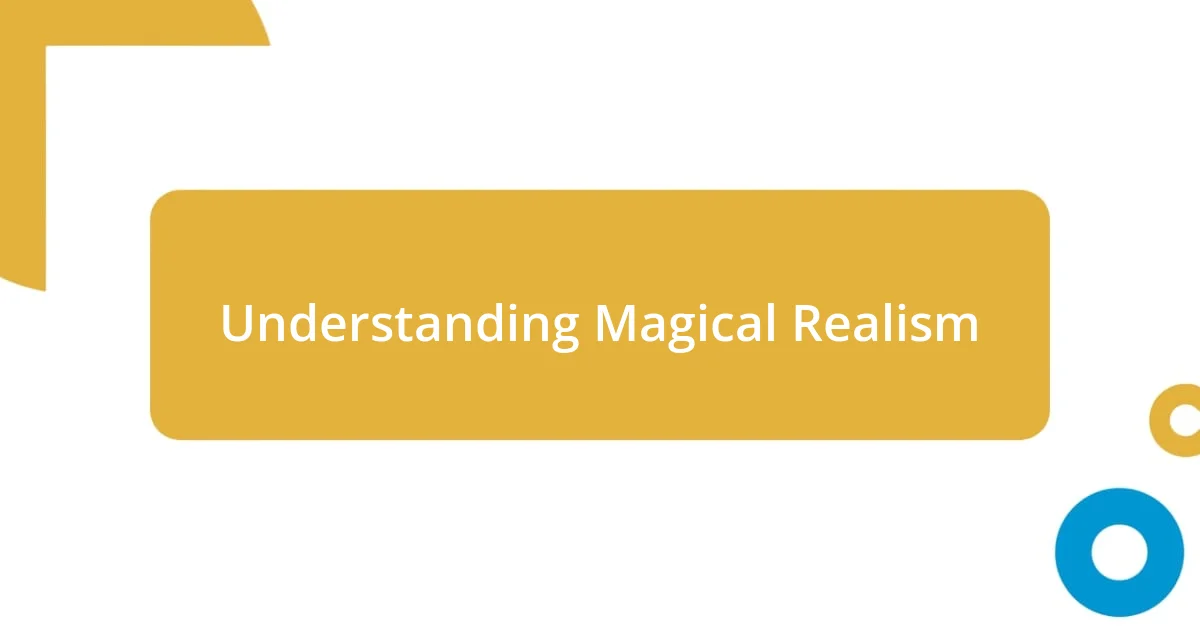
Understanding Magical Realism
Magical realism, at its core, beautifully weaves the extraordinary into the fabric of everyday life. I remember reading Gabriel García Márquez’s One Hundred Years of Solitude for the first time; the way time seemed fluid and characters lived with the weight of both the magical and the mundane captivated me. How can one genre hold such profound truths about our reality while infusing it with fantasy?
Emotional resonance is a hallmark of magical realism. The stories often evoke feelings that mirror our own experiences, making the fantastical elements feel more relatable. I once found myself tearing up at a scene where a character’s grief manifested as blooming flowers. Isn’t it fascinating how something so surreal can encapsulate a deep emotional truth we all understand?
Understanding magical realism also involves recognizing its roots in cultural narratives. It serves as a bridge between myth and reality, often reflecting the complexities of identity and societal issues. I’ve often pondered how these stories allow us to grapple with both our personal and collective histories in ways that pure realism simply can’t convey. Are we not more than mere observers of our world, but rather active participants in a larger, magical tapestry?
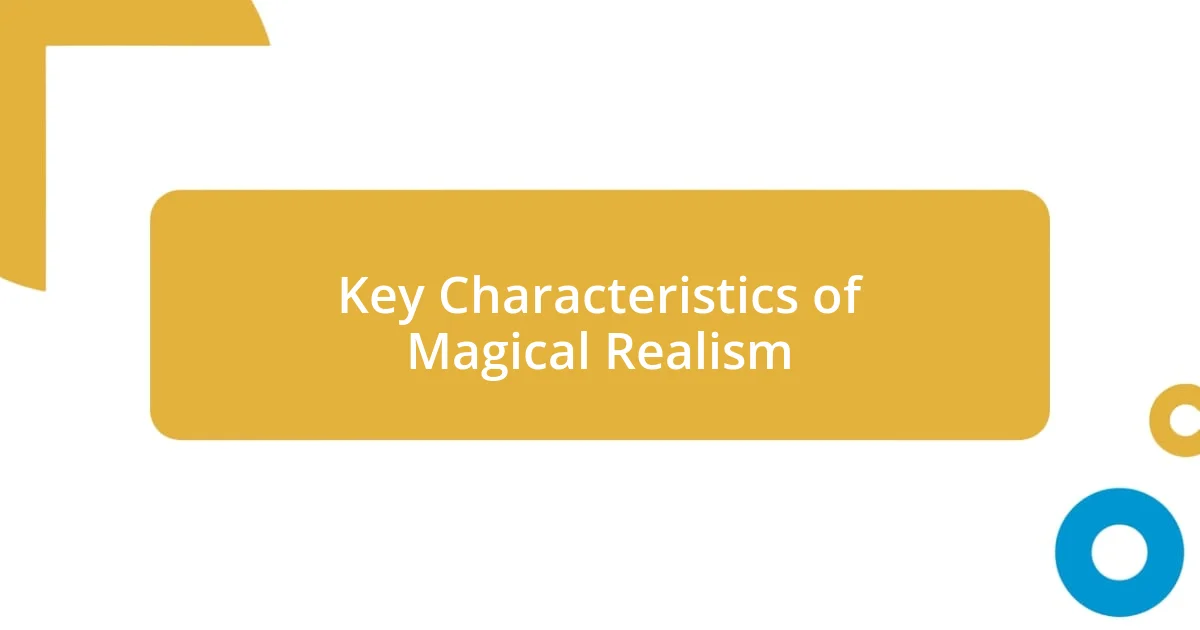
Key Characteristics of Magical Realism
Magical realism thrives on the seamless blend of the ordinary and the extraordinary. It’s not just about inserting fantastical elements into a realistic framework; it’s how these elements coexist without consequence. I remember a novelist friend sharing a story where a character converses with a ghost as if it’s a normal part of his day. It struck me how this normalization of the surreal creates a unique lens through which we can view our own bizarre experiences.
Another characteristic is the detailed setting that grounds the magical aspects. The vivid descriptions in these stories often transport me to vibrant places, like a bustling market filled with talking animals or a street where rain falls upward. This richly woven backdrop not only makes the magical elements feel authentic but also invites the reader to immerse themselves fully in this enchanting world. I often find myself daydreaming about visiting such places, where the line between the unbelievable and the real blurs.
Characters in magical realism are not just players in the story; they embody the struggles of their cultures, often reflecting societal issues. I once encountered a tale where a protagonist’s reality warped during a political upheaval, illustrating how personal and collective histories intertwine. It’s this layer of depth that keeps me hooked, revealing truths about identity, belonging, and the human experience that resonate long after I’ve turned the last page.
| Characteristic | Description |
|---|---|
| Blend of Ordinary and Extraordinary | Magical elements co-exist with reality without disruption. |
| Richly Detailed Settings | Creates an immersive experience, making magical aspects feel authentic. |
| Culturally Reflective Characters | Embodies societal issues and personal struggles, adding layers of meaning. |
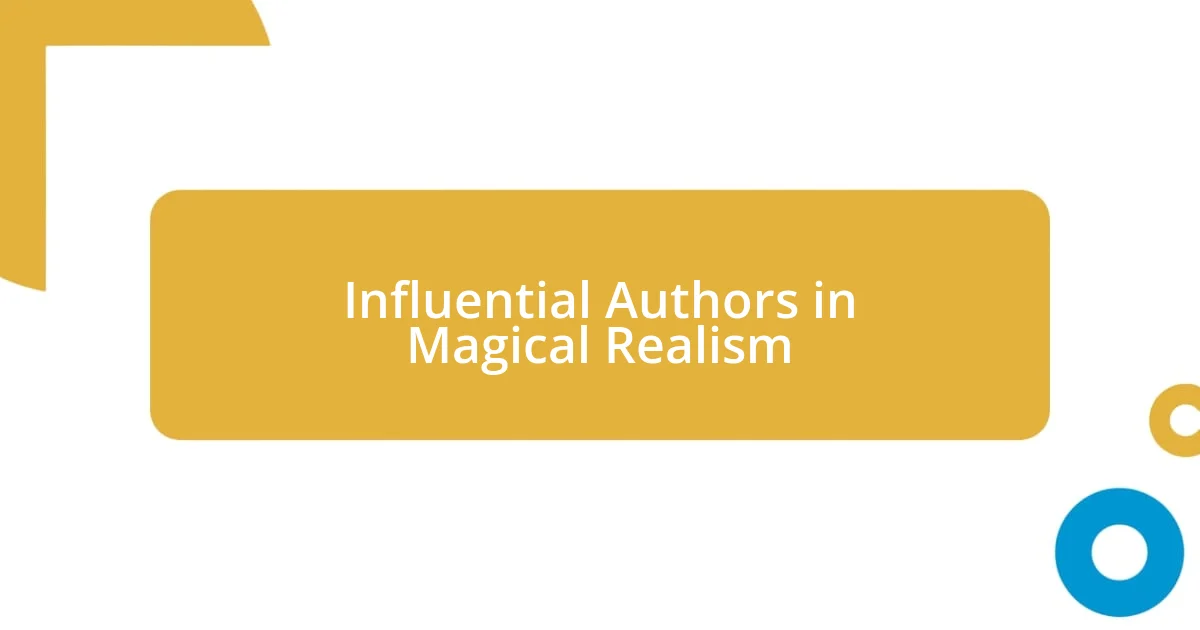
Influential Authors in Magical Realism
Magical realism has been shaped by a multitude of influential authors who each brought their unique flair to the genre. For instance, Gabriel García Márquez not only popularized the term with his evocative storytelling but also introduced readers to the nuance of Latin American culture. I still remember the profound impact his imagery had on me, like when the rains brought memories flooding back, intertwining the past with the present in ways I had never considered before.
Another pivotal figure is Isabel Allende, whose works often explore themes of love and loss intertwined with historical events. I can think of how her novel The House of the Spirits parallels real political turmoil while introducing elements like clairvoyance that made the narrative feel almost like a personal history. There’s something so immersive about reading her stories—it’s as if you’re stepping into a world where every emotion is heightened by the magical.
Here’s a brief list of other influential authors in magical realism, each adding layers to this captivating genre:
- Jorge Luis Borges: Known for his intricate narratives that blur the line between reality and illusion.
- Toni Morrison: Fuses the fantastical with historical experiences, exploring deep cultural narratives.
- Salman Rushdie: Weaves magical elements into the fabric of societal commentary, seen in works like Midnight’s Children.
- Laura Esquivel: Blends culinary arts with emotional landscapes in Like Water for Chocolate, making the ordinary feel extraordinary.
Each of these authors brings a distinct voice and cultural perspective, enriching the landscape of magical realism and inviting us to explore the beauty in blending the mundane with the marvelous.
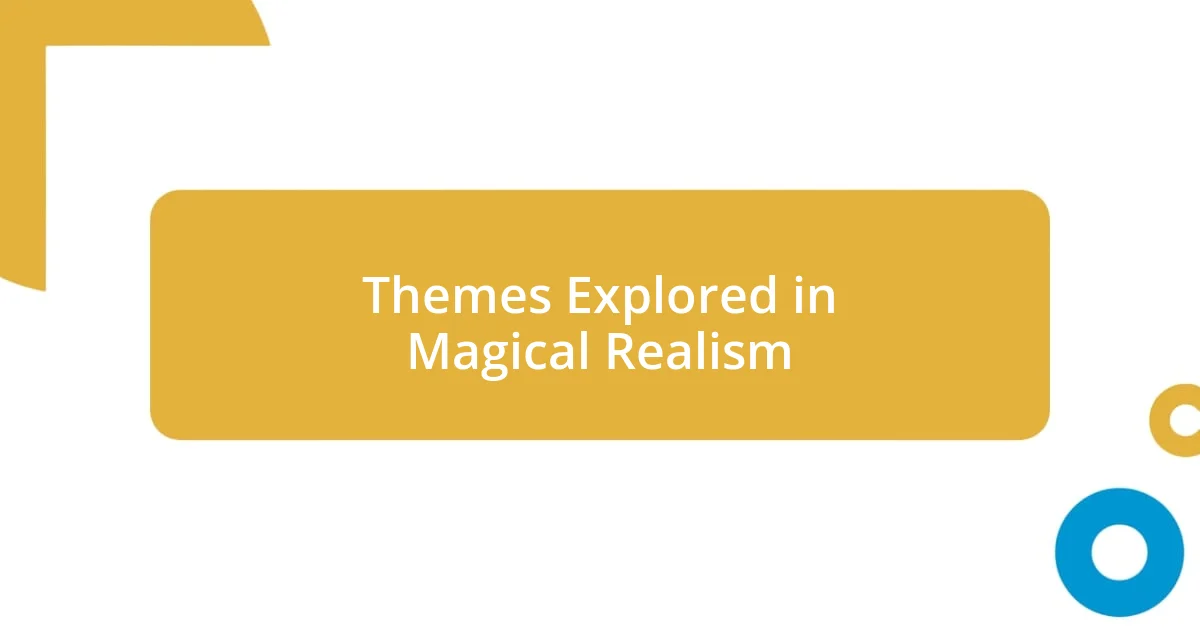
Themes Explored in Magical Realism
The interplay of reality and fantasy in magical realism often opens a dialogue about identity and cultural memory. I recall feeling a deep connection to a story that highlighted the weight of family legacies—where ancestral spirits influence the living. It made me ponder, don’t our pasts shape who we are? This exploration invites readers to reflect on their own histories, realizing how often we carry the echoes of those who came before us.
Another prevalent theme is the juxtaposition of social issues against a fantastical backdrop. In one unforgettable tale, a character experiences surreal visions during a climate crisis, forcing them to confront the devastating effects of environmental neglect. I found myself wondering—how often do we let the extraordinary reflect our harsh realities? This blend not only serves as a poignant critique but also reminds us that sometimes, it takes the bizarre to awaken our senses and drive societal change.
Love and loss resonate powerfully within this genre, often portrayed through surreal moments that heighten emotion. I remember reading a novel where the protagonist’s grief manifested into tangible creatures, embodying her sorrow yet providing a sense of companionship. Can you imagine what it would be like to face our pain as a living entity? Such powerful imagery not only makes the intangible concrete but also invites us to explore our feelings of joy and heartbreak in ways that are profoundly relatable.
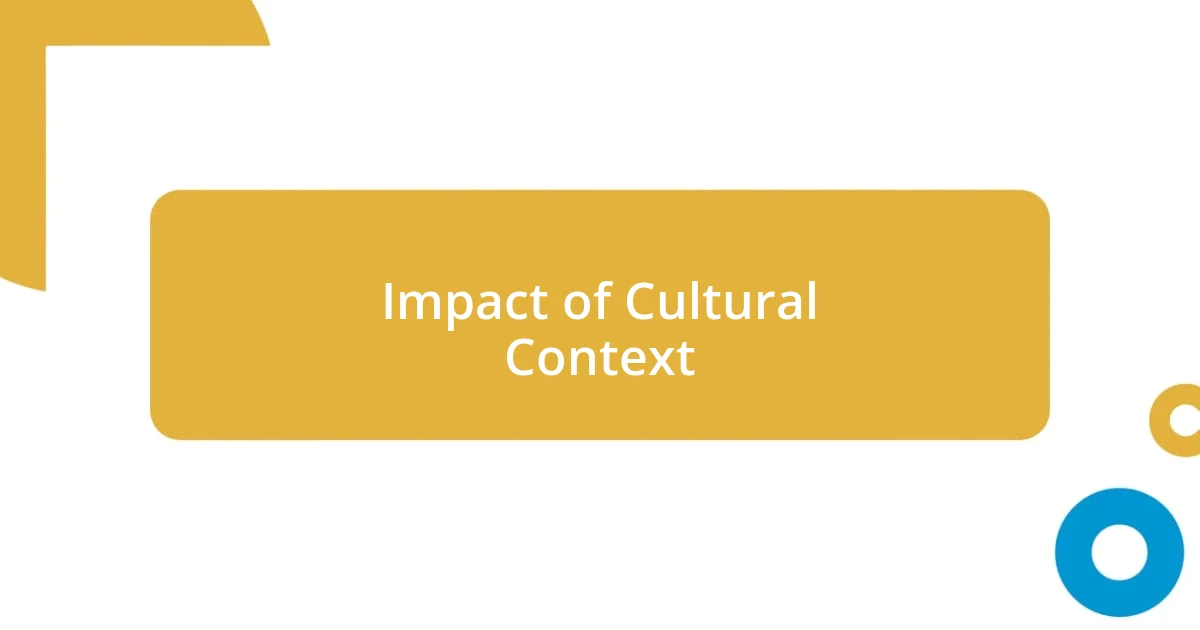
Impact of Cultural Context
Cultural context plays a vital role in shaping the narratives within magical realism. When I reflect on my reading experiences, it’s fascinating how each author’s background imbues their stories with unique flavors. For example, I remember reading a tale rooted in Indigenous folklore, where the trees had voices, echoing the ancestors’ wisdom. It made me think about how these cultural elements not only tell a story but also serve to preserve and celebrate traditions that might otherwise be forgotten.
The richness of cultural history often brings depth to magical realism that resonates with the reader. I can still feel the emotional weight of a story steeped in historical events, where characters navigate their reality while grappling with the scars of colonization. It raises an important question: how do our collective histories influence our view of the world? I find that stories steeped in cultural context bridge the gap between personal and communal experiences, allowing us to reflect on the shared human journey.
Moreover, the way magical realism allows for the blending of the ordinary with the extraordinary often mirrors the complexity of our cultural identities. I recall a narrative that intertwined urban life with myth, creating a magical landscape where community and tradition clashed yet harmonized. Isn’t it incredible how this genre compels us to confront our multifaceted identities? It’s through these stories that we get a glimpse into the heart of different cultures, sparking curiosity and empathy that can transcend borders.
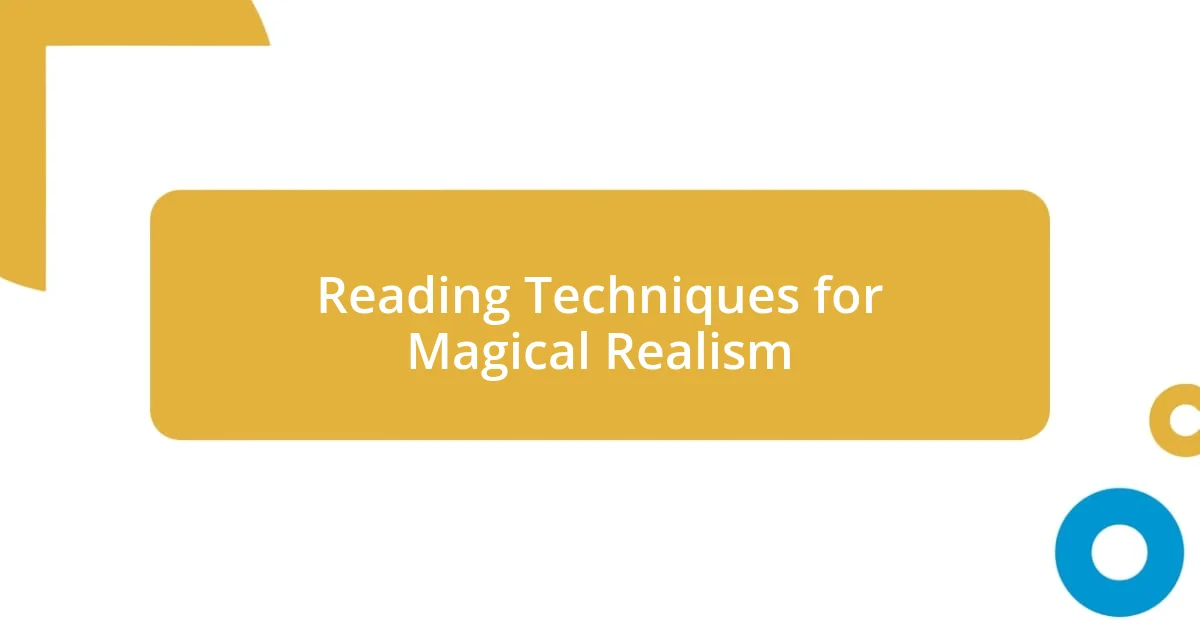
Reading Techniques for Magical Realism
To fully immerse yourself in magical realism, I recommend embracing a mindset of wonder. Each reading session invites you to approach the text with an open heart, ready to suspend disbelief and explore the extraordinary. I remember when I first did this; a story seemed to come alive in ways that made me question my daily reality. Have you ever felt that tingling excitement of discovering something magical hidden within the mundane?
Another technique I often use is to note the minute details that blend the fantastical with the everyday. For instance, I vividly recall a passage where a character’s coffee cup would change colors with their emotions. This small detail ignited my imagination, urging me to reflect on how often our feelings go unnoticed in the rush of life. It’s like each word in magical realism acts as a bridge to our own experiences—an opportunity to connect the unusual with our personal narratives.
Engaging with the characters on an emotional level is crucial as well. I once found myself deeply empathizing with a protagonist who conversed with shadows, each shadow revealing unspoken fears. It struck me then—how often do we quiet our own voices in the face of fear? This connection adds a layer of depth, inviting reflection on our struggles and triumphs while reinforcing the idea that magic can exist alongside our stark realities.
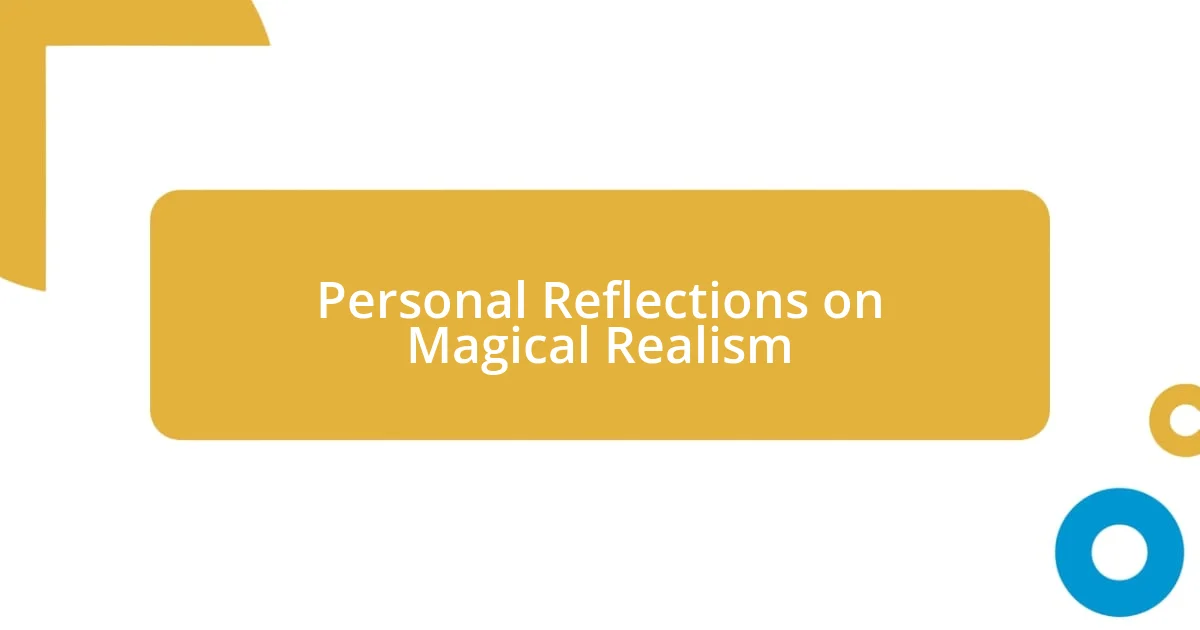
Personal Reflections on Magical Realism
Reflecting on my journey through magical realism, I often find myself captivated by the unique way it reshapes our understanding of reality. I remember a story that featured a house with walls that breathed, mirroring the emotions of its inhabitants. That imagery lingered with me, stirring a sense of curiosity: could our surroundings really be so alive? It’s moments like these that remind me how magical realism invites us to question the very nature of our existence.
In diving deeper into this genre, I’ve realized how it illuminates the emotions we sometimes overlook. I once read about a character who danced with the winds, and it made me reminisce about my childhood days playing outside, feeling like anything was possible. This blend of nostalgia and wonder led me to ponder—what hidden magic exists in our everyday lives? It’s these connections that make magical realism a repository of both joy and introspection, encouraging a closer look at our own experiences.
Moreover, I cherish the moments when magical realism prompts me to reflect on societal truths. I read a tale where whispered secrets turned into visible butterflies, representing suppressed voices yearning to be heard. This left me questioning—how many voices in our communities remain unheard? Through these extraordinary narratives, I’ve come to appreciate the power of storytelling not just as entertainment but as a profound tool for understanding our world and ourselves.






